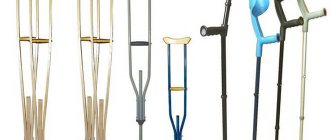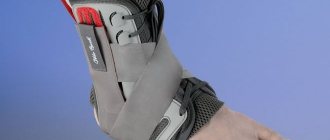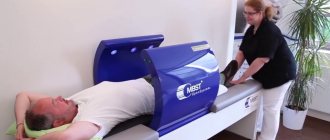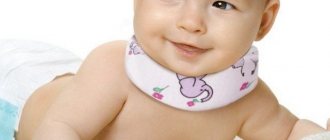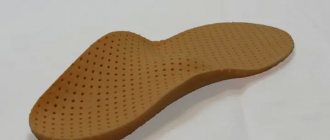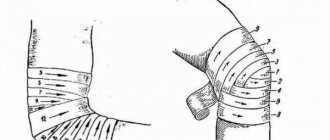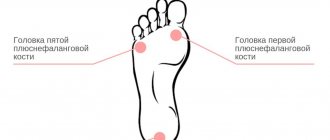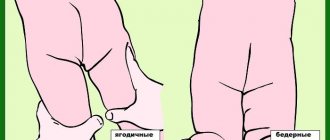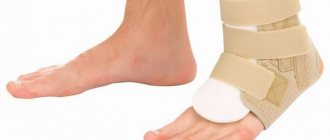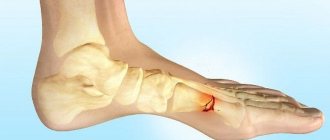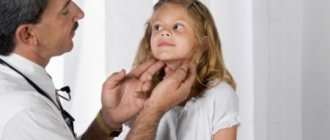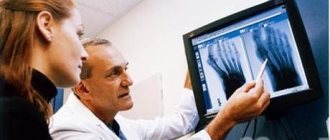Freyka's pillow.
A common cause of hip dysplasia in infancy is the breech presentation of the fetus in the mother's womb. Soon after birth, a complete examination of the child is carried out. When a pathology is detected, treatment begins immediately. When choosing treatment methods, pediatric orthopedists take into account the degree of inferiority of the hip joint. To treat dysplastic changes in the joints, special devices are used for permanent wear.
One of them is Freika’s pillow (bandage, feather bed, spacers). A soft orthopedic product fixes and holds children's legs bent at the knees in an extended position, ensuring the correct formation of the joints. Using the pillow for several months eliminates pre-luxations, subluxations, and prevents the occurrence of complications associated with dysplasia.
A little history
The Freik pillow was developed by the Austrian orthopedist B. Freik in the last century. The main purpose of such a product is the treatment of hip dislocation in newborns. Initially, such a device was made from eiderdown placed in waterproof fabric. This bandage was stitched several times so that the filler did not get lost.
After some time, orthopedists came to the conclusion that such a design was insufficiently rigid. As a result, other materials began to be used to make Freyk's feather bed.
Contraindications
It is prohibited to use any orthopedic devices without a doctor's prescription. If parents have any suspicions about insufficient examination of the child after birth, they should contact their pediatrician. Self-treatment of non-existent dysplasia can cause curvature of the legs and the development of valgus deformity of the joints. The Frejka pillow is not used in therapy in the following cases:
- pathologies of the skin of a recurrent nature;
- congenital or acquired hip dislocation;
- diseases in which it is impossible to fully spread the baby’s legs to the sides.
The use of a pillow in treatment is refused if the child is individually intolerant to the materials used in its manufacture. Clinically, it manifests itself in the form of an allergic reaction that occurs like urticaria.
In what cases is it prescribed
Freyka's perinka is an orthopedic device. Therefore, it is recommended to use it for:
- subluxation of the femoral head;
- mild dysplasia;
- pre-dislocation of the femoral head.
At the same time, most specialists of a narrow profile claim that such a bandage is useless for dislocations. Orthopedists believe that such a device does not provide the necessary retraction of the legs to the side. As a result, it is difficult to achieve the desired direction of the bones in the joint.
Produced by
Freyka's perinka, the photo of which is presented above, is produced not only by foreign manufacturers, but also by domestic prosthetic and orthopedic enterprises. Among such companies, Ortho-Med occupies a leading position. The enterprise is located in Chelyabinsk.
If necessary, such a bandage can be made independently. The most important thing is to know exactly the dimensions of the device. Freyka's perinka should not be too small or too big for the child. It is also necessary to carefully select the material.
How much does a Freika pillow cost?
In stores, the cost of an orthosis varies from 1000 to 1500 rubles.
Freyka pillows vary in the materials used in their production.
In many ways, the price may depend on the quality of the materials used in production. You need to pay close attention to them to avoid unwanted allergic reactions.
Orthopedic devices are produced by many domestic and foreign manufacturers.
Perinka Freyka: dimensions
How to choose a bandage? First of all, you need to decide on the size. Most manufacturers, as well as those who make Freyka's feather bed to order, focus on the distance between the knees when they are abducted to their maximum width in a bent state. This indicator may be:
- 25-26 cm;
- 23-24 cm;
- 21-22 cm;
- 19-20 cm;
- 17-18 cm;
- 15-16 cm;
- 14 cm.
According to these parameters, Freyka's feather bed is made. In addition, when prescribing a bandage, the age of the baby is taken into account. What is Freika's feather duster like? Dimensions may be as follows:
- XS – the bandage is intended for children aged 1 to 6 months;
- S – for children aged 6-12 months;
- M – for children aged 1 to 2 years.
A bandage is very rarely used to treat dysplasia in a one-year-old child. Experts have not yet come to an agreement on this issue. Some believe that Freik's feather dust helps solve the problem. Other orthopedists argue that there are more modern methods of therapy.
Which is better – Pavlik stirrups or Freik’s pillow?
Pavlik stirrups, like the Freik pillow, were invented to treat identified disorders in the development of the hip joint.
There are those who prefer to treat with stirrups, and there are those who are sure that the Freika pillow is more effective.
The splint cushion helps maintain the legs in a bent state, but with the knees apart. Despite the fairly clear fixation of the legs, the lower part of the limbs is free and the baby can move and twitch them slightly.
Indications for their use are hip dysplasia.
Pavlik stirrups are a much more serious device and are used when an orthopedic doctor has diagnosed more radical deviations from developmental norms.
The design is a chest bandage with straps on the shoulders and under the knees.
In this design, the legs are fixed quite rigidly, also maintaining the required angle of their spread.
Pavlik stirrups have one significant disadvantage - they are never removed and the child is in them 24 hours a day, regardless of the need to bathe or sleep.
First use
Now you know what Freyka's feather duster is. How to wear such a device? It is very important that the first application of the bandage is carried out by an experienced doctor. Only an orthopedist can determine the necessary abduction of the child’s legs. At the same time, parents will be able to understand how to properly fix the splint.
It is worth noting that the use of such a bandage causes many inconveniences. A child with Freyka's feather bed reminds many of a frog or a parachutist. When using the product, the baby's legs spread greatly to the sides. This causes a number of difficulties. It is especially difficult to dress a child. After all, his legs are spread so that the angle at the hip joint is 80˚. In this position, the child's knees remain bent. It is worth considering that the course of therapy can last from 2 to 3 months. All this time, the position of the legs does not change when using the bandage.
Best Producer
Perinka Freyka with additional stiffening ribs
The Freika pillow for newborns is produced by several orthopedic companies. The most popular of them:
- Trives;
- Orlett;
- Ecoten;
- Ogonyok;
- Fosta;
- ORTHO.
Each manufacturer is distinguished by the presence of modifications of the splint that are suitable for certain variations in the course of pathologies of the child’s musculoskeletal system. Some models have stiffening ribs that provide better fixation of the device. Others may be equipped with additional adjustment straps and options for adjusting the position of the pillow on the child's body.
It is impossible to say unambiguously which company or product model has the highest priority.
How to put on a bandage
To make your child feel comfortable, you need to put the bandage on him correctly:
- Put your baby in clean cotton onesies.
- Spread Freyk's feather bed on the changing table. Place the baby on top. The crotch should be located in the center of the cushion.
- Spread the legs to the required distance until there is a slight springy effect.
- Attach ribbons to the side of the child's waist. In some models, these parts are fixed on the baby's hips.
- Cross the straps and then fasten the bandage.
When putting on for the first time, the minimum angle of spread of the legs should be from 30 to 40 degrees. This figure should be increased gradually.
What difficulties might there be?
Parents should prepare themselves mentally, since using Freik's featherbed requires a certain period of adaptation. At first, it is very uncomfortable for the child to be in the same position for a long time. Therefore, the baby can be very capricious.
During the treatment period, it is very important to follow all the doctor’s recommendations, choose the right clothes for the child, constantly care for his skin, and so on. It is worth noting that the baby’s adaptation period proceeds in different ways and can last from 2 days to a day. It all depends on the character of the child. With patient and proper training of your baby to Freik's feather bed, you can achieve a positive result. After some time, the child begins to take the position of his legs for granted. The most important thing is that parents understand the importance of such therapy. Wearing a bandage for dysplasia gives the baby the opportunity to move freely and independently in the future.
How to put on the device
It is important to correctly fix the child’s legs in a physiological position. The child will quickly get used to the foreign object, and recovery will come much faster. At the appointment, the orthopedic doctor will show you how to put on and secure the Freika pillow on the baby’s body. If necessary, you can check the instructions for use included in the package.
Carefully read the instructions on how to properly put on an orthopedic product.
When putting an orthopedic device on a newborn, you should follow the following recommendations:
- You cannot put a pillow over a diaper. You can avoid excessive sweating and chafing of delicate baby skin by lifting cotton underwear;
- wear the product straightened out. The baby is placed on top so that a dense cushion is located at an equal distance between the thighs;
- Avoid squeezing the case with the strap system. The fastenings prevent the pillow from moving, securely fixing it in one position. But the belts should not leave red marks on the skin as a result of strong compression of the skin.
Within a month of life, children get used to moving their legs and arms freely, so after putting on the bandage for the first time, they begin to be capricious. Here parents should be persistent and not stop using the pillow. This will significantly shorten the period of adaptation to the Freik pillow. If a child cries and cannot be distracted with a toy or a walk, you need to check whether his knees are too far apart. After reducing the degree of abduction, the baby’s condition usually normalizes. The design of the product includes a fastening system that allows the belts to be lengthened as the baby grows. But still, over time, parents of children who are indicated for long-term therapy have to purchase a larger Freik pillow.
“Doctors are hiding the truth!”
Even “advanced” joint problems can be cured at home! Just remember to apply this once a day...
>
If a child is diagnosed with serious joint instability, doctors recommend wearing the device around the clock. In other cases, using it for 12 hours is sufficient. You should remove the pillow for a short time - when swimming, during massage procedures, and gymnastics.
Recommendations from orthopedists
So, how to choose Freika's feather bed? First of all, you need to decide on the size. In this case, not only the age of the child is taken into account, but also the distance between the knees in the apart position. Only an orthopedist can determine this indicator. When choosing a finished product, you should give preference to those that can be adjusted. Otherwise, the bandage will have to be changed after a few months.
When using such a tire, you should take into account the recommendations of specialists:
- The child should wear light clothing made from natural materials under the pillow or under the straps. It should allow air to pass through and absorb moisture well.
- Before washing the product, you should remove all hard elements. This will avoid mechanical damage to parts.
- It is recommended to wash Freyka's feather bed by hand using detergents that do not cause allergies.
Models of children's bandages
Freyka pillows vary in the materials used in their production. According to international standards, the presence of synthetics, plastic, and metal in products is allowed. But the internal surfaces of devices that come into contact with the baby’s skin should be made only from natural hypoallergenic materials.
Plastic
This is the hardest Freik pillow model. Its lower part is made of easily bendable plastic, and the shape of the model vaguely resembles a saddle. Straps for fixation are located on the back and sides. This fastening system prevents even slight movement of the product. In some models, the belts immobilize the hip joints so firmly that they are used instead of plaster splints.
Freyka pillow in plastic design.
It is not advisable to use these complex structures for mild dysplasia due to the inconvenience of wearing, especially when treating children taking their first steps. Plastic orthopedic devices have significant disadvantages:
- during their use, children sweat a lot, which can cause irritation of delicate children's skin, and sometimes the development of dermatitis;
- The design provides for the possibility of only maximal extension of the child’s legs.
It takes a very long time for children to adapt to wearing Freyka’s plastic pillow. Sometimes this period drags on for several weeks, during which the child is constantly capricious, which worries the parents.
Polyurethane foam
Frequently used models of Freika pillows in pediatric orthopedics are made of polyurethane foam. They are always available in the assortment of orthopedic salons. The dense part of the device, located between the legs, is made of this material. A characteristic feature of this model is the presence of a “memory effect”. When put on again, the roller immediately takes on a comfortable shape. The device reliably fixes the hip joints, but strong pressure on the body is completely eliminated.
Polyurethane foam product.
Manufacturers used mesh material in the manufacture of the backrest to prevent excessive sweating and skin irritation. When choosing models, orthopedists pay attention to the pillow fastening system. On some, the straps are located in such a way that when the child moves suddenly, their tension is weakened. This is inconvenient to use and reduces the therapeutic effect. Therefore, doctors do not recommend using pillows if they require straps on the shoulders to secure them.
Combined
The design of such Freyka pillows includes stiffening ribs. But unlike plastic devices, wearing them does not greatly limit the child’s mobility. There is practically no adaptation period, since children can freely roll over, sit, and crawl. The device is made of mesh material that allows air to pass through well. In addition to the stiffeners, natural hypoallergenic wool was used in production to prevent the pillow from slipping and skin irritation.
Combined device.
The fastening system is located on the top and side surfaces of the bandage. The straps are made of elastic materials and are secured with durable Velcro. Combined models are very convenient to use, easy to take off and put on.
Homemade
The cost of some models is several thousand rubles, and taking into account the need to change bandages, the cost of treatment increases several times. Therefore, some parents make their own Freyka pillows using special patterns. To create a roller, flannel is used, which is twisted in several layers, and belts and clamps are purchased in stores. The only advantage of such models is the individually selected fastening system. And there are much more disadvantages: insufficient rigidity of the pillow, rapid stretching of the straps, the use of non-hypoallergenic materials, inconvenience in care. But the most important thing is that a self-made bandage does not provide a sufficient degree of fixation of the hip joints.
When to worry
Freyka's perinka, reviews of which are both positive and negative, can greatly bother a child in some situations. If the baby is capricious for a long time and does not calm down even in the mother’s arms, then his legs are strongly retracted to the sides. This bothers the child and causes a feeling of discomfort.
In such situations, it is worth contacting an orthopedist and reducing the abduction of the legs. In this case, consultation with specialists is simply necessary.
Product Features
— The Perinka Freyka bandage is of a non-fixed size, that is, you can adjust the width and height of the device yourself.
— The device’s soft shoulder pads prevent chafing and also create additional comfort.
— The bandage is 95% cotton and 5% polyester. The device is filled with isolon.
In conclusion
Do not forget that the treatment of subluxation, dislocation or pre-luxation of the femoral head is a problem that requires a competent approach. First you need to eliminate painful contractures. In this case, it is necessary to limit movement in the hip joint. For this purpose, a strengthening massage is carried out, as well as exercise therapy. Only after the listed procedures can an orthopedist prescribe the application of a bandage such as Freika's feather bed. It is recommended to practice gradual abduction of the child’s legs to an angle of 80 degrees.
Only such therapy allows you to get a positive result and achieve normal development of the hip joint in the baby. Otherwise, a rather serious complication may develop - aseptic necrosis.
